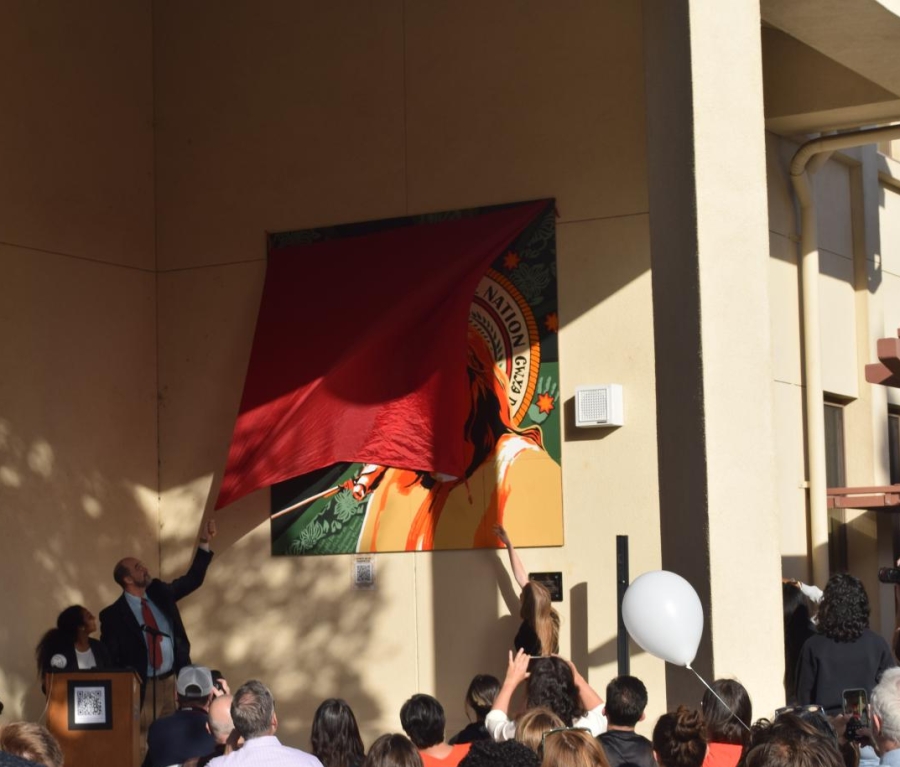Mural with a mission: Social justice artwork honors delegate
RADIANT REVEAL — Social Justice Pathway History teacher Eric Bloom and Art Lead Kellyn Scheel excitedly remove the tarp from the mural on April 24. The mural took over a year to complete. “It’s silly stupid how much time they put into this,” Bloom said. “And not for a grade, not for credit, not for a class, but so that they can say ‘this is something that we’ve done.'” Photo: Lizzy Williams
Amid thunderous applause, students pull a tarp off of the wall to reveal a vibrant mural of green, red and gold.
The mural, which hangs in front of Palo Alto High School’s math and social science building, was a project spearheaded by students in the campus’ Social Justice Pathway, a program in which students’ English and History classes are rooted in themes of social change and project-based learning. It depicts Kimberly Teehee, the Cherokee Nation’s appointed delegate to the United States House of Representatives.
The significance of the role to the Cherokee Nation dates back to 1835, when the United States government used the Treaty of New Echota to push Cherokee residents from their homeland in Georgia to a reservation in Oklahoma. Thousands died of disease and starvation along the way, which came to be known as the Trail of Tears.
As part of the treaty, the Cherokee Nation was guaranteed a delegate to represent it in the House of Representatives. However, no delegate was ever seated. For this reason, the Cherokee Nation has campaigned since 2019 for a delegate to represent it in Congress.
“It [my seating] would send a huge message to everyone … that the United States honors its treaty rights,” Teehee said. “We [Native Americans] have too few champions as it is, and having another seat at the table only helps all of Indian country, not just the Cherokee Nation.”
Teehee has decades of experience advocating for Native American communities, notably as the first Senior Policy Advisor for Native American Affairs under former president Barack Obama. While the Democratic-controlled House Rules Committee held a hearing in 2022 in which members of Congress expressed interest in seating a delegate, the House has yet to call a simple-majority vote on whether she may be seated, four years after she was appointed.
For decades the Cherokee Nation has been stricken with generational poverty and climate change has hurt crop yields, as well as an ongoing opioid crisis. As a delegate, Teehee would be able to promote legislation addressing these issues and manage communications between the Cherokee Nation and the federal government, though she would be unable to vote on the final passage of legislation — similar to the roles of delegates from U.S. territories.
Teehee said that initially, she was surprised to hear that high school students in California were interested in her campaign.
“I was kind of in awe of students that would want to learn about our history … without any kind of expectation of getting credit [for school],” Teehee said. “They became passionate about something that benefits the Cherokee Nation, and I just found that really remarkable.”
Teehee said she believes that the mural and the media attention it will receive will have a substantive impact on the decisions of policymakers in Washington, D.C. In addition to the mural, members of Paly’s Social Justice Pathway designed and wrote postcards urging local congresspeople to fight for Teehee’s seating.
“California happens to be the home of some very important members of Congress.” Teehee said. “Having young people present their voice and attach it to this very important issue will resonate with the members of your own congressional districts, as well as across the country.”





